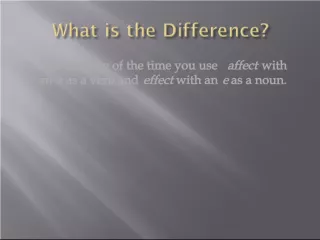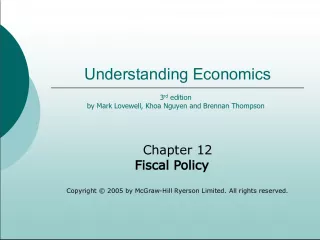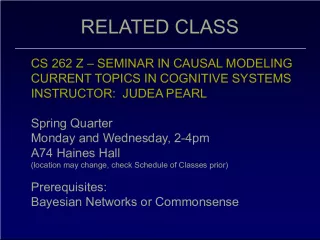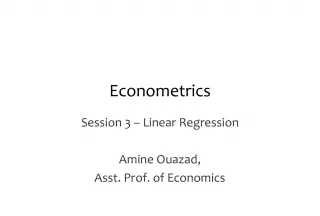The Butterfly Effect


The flapping of a single butterfly's wings can create a ripple effect that ultimately impacts the state of the atmosphere over time.
- Uploaded on | 0 Views
-
 ryderharris
ryderharris
About The Butterfly Effect
PowerPoint presentation about 'The Butterfly Effect'. This presentation describes the topic on The flapping of a single butterfly's wings can create a ripple effect that ultimately impacts the state of the atmosphere over time.. The key topics included in this slideshow are . Download this presentation absolutely free.
Presentation Transcript
Slide1The flapping of a single butterfly'swing today produces a tiny change in the state of the atmosphere. Over a period of time, what the atmosphere actually does diverges from what it would have done. So, in a month's time, a tornado that would have devastated the Indonesian coast doesn't happen. Or maybe one that wasn't going to happen, does. (Ian Stewart, Does God Play Dice? The Mathematics of Chaos , pg. 141)
Slide2•Newton’s laws are deterministic-if you know the initial conditions you can predict the outcome • No real measurement is infinitely accurate-always have some uncertainty • So initial conditions can never be 100% accurate • Henri Poincare-interested in equations for the motion of planets orbiting the sun. Motion equations are an application of Newton’s Laws • Find velocity and positions planets now should be able to predict where they’ll be in say 100 yrs time (or any time) • CANNOT measure these to infinite accuracy • At this time was assumed shrinking uncertainty in initial measurements would shrink the uncertainty in the prediction • Poincare noticed that this doesn’t always happen!!! • Eg. In a three body system-eg the sun moon and earth system. A tiny uncertainty in the initial measurements would grow at a huge rate • For these systems the only way to produce accurate predictions would require knowing the initial conditions to an infinite degree of accuracy And so we have dynamical instability or CHAOS!!!
Slide3The 3 body problem:http://www.upscale.utoronto.ca/GeneralInterest/Harrison/Flash /Chaos/ThreeBody/ThreeBody.html The logistic map (population predictions): http://www.upscale.utoronto.ca/GeneralInterest/Harrison/Flash /Chaos/LogisticMap/LogisticMap.html Physics animations: : http://www.upscale.utoronto.ca/GeneralInterest/Harrison/Flash /#chaos
Slide5The Lorenz Attractor• The meteorologist Edward Lorenz had a computer set up, with 12 equations, to model the behaviour of the upper atmosphere. • One day he wanted to run the model from the middle, not the beginning, and so typed in the conditions that he had on a print out. He printed model to 3dp but the computer stored numbers to 6dp. He entered .506 wheras the computer stored the number as .506127 • He entered the number and let it run for an hour. When he came back he was surprised to see the prediction was completely different to the original.
Slide6he simplified the 12 equations into 3 that had nothing to do with theweather (convection): dx/dt = s * (x - y) dy/dt = -x*z - y + r * x dz/dt = x * y - b * x Here x, y and z are variables and we will think of t as being the time; s, r and b are constants. Solved the problems with a computer: Attractors almost lie in the same plane-so the dimentionality of the attractors is a bit larger than 2. It has fracional dimensionality and can be called a fractal. All chaotic systems exhibit fractional dimensionality Technical note: the above solution to the Lorenz equations had initial positions of x = 0, y = 1 and z = 0. The constants were r = 28, s = 10, and b = 8/3. The time t goes from 0 to 2048. Not all solutions of the Lorenz equations are chaotic; the crucial factor is the value of the constant r. http://www.upscale.utoronto.ca/GeneralInterest/Harrison/Fl ash/Chaos/Lorenz/Lorenz.html
Slide7•At what point does a system change from periodic to chaotic? x n+1 = rx n (1-x n ) Where r = growth rate Increased growth rate more rabbits are born-increase population (1-x n ) more die from increased competition reducing population r=large enough- chaos Split twice, 4 times, 8 times etc Feigenbaum-calculate exact parameter values produced splitting ( period-doubling bifurcations )-obtained geometric convergence. Ratio of 2 nd to 1 st and 3 rd to 2 nd same!!! Ratio of convergence-4.699 (3dp) Occurs in a wide variety of mathematical functions prior to the onset of chaos Geometric convergence means something in the equation was scaling. In chaotic system-some quality being preserved-regularity beneath surface.
Slide8Where is the Feigenbaum sequence coming from?• Complex plane • Translate Feigenbaum functions into complex plane –get family of shapes JULIA SETS • Look at the Mandlebrot set –where set intersected the real number line – Feigenbaum sequence of bifurcations • FRACTALS have SCALING!!!
Slide10•http://online.redwoods.cc.ca.us/instruct/dar nold/DEProj/Sp98/Gabe/ • Information theory























